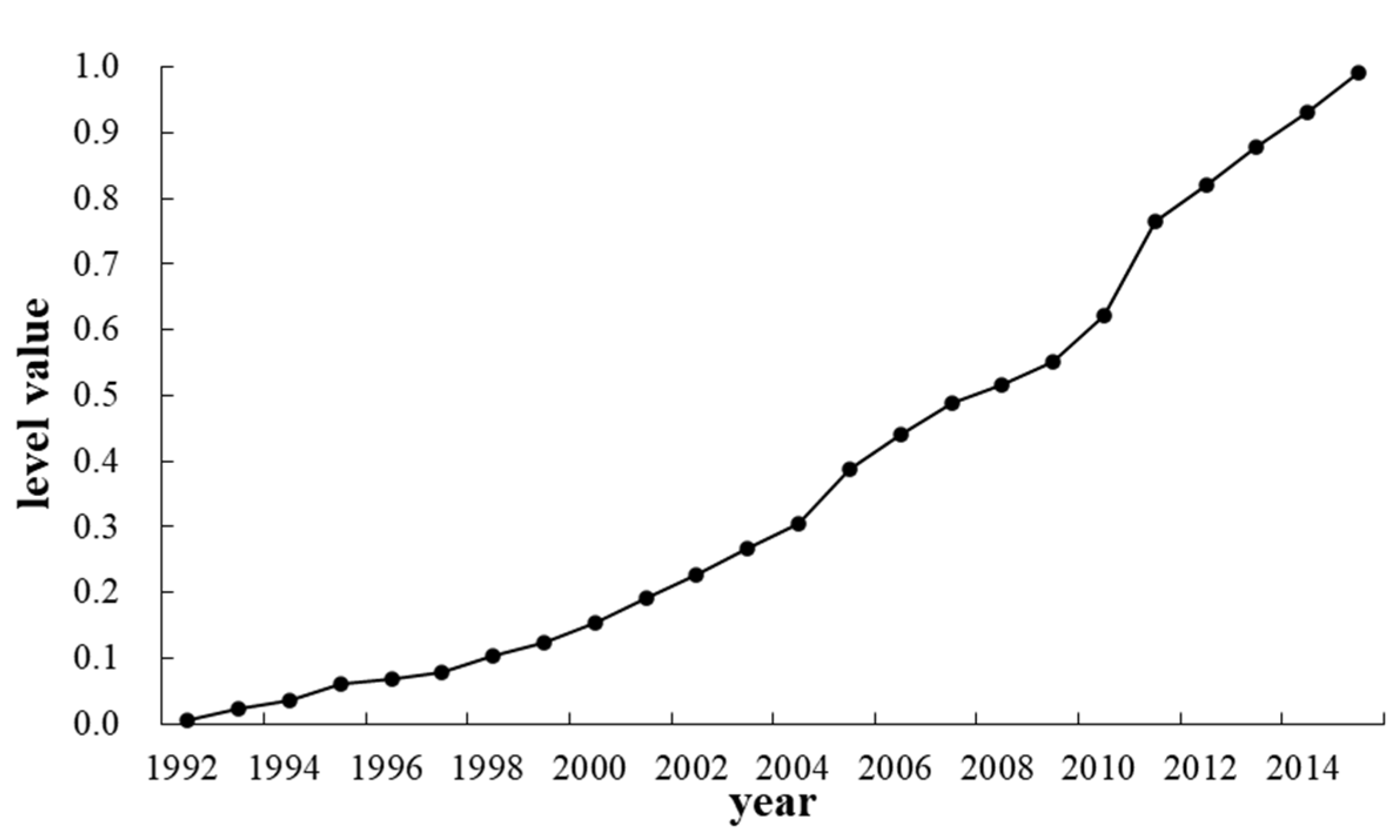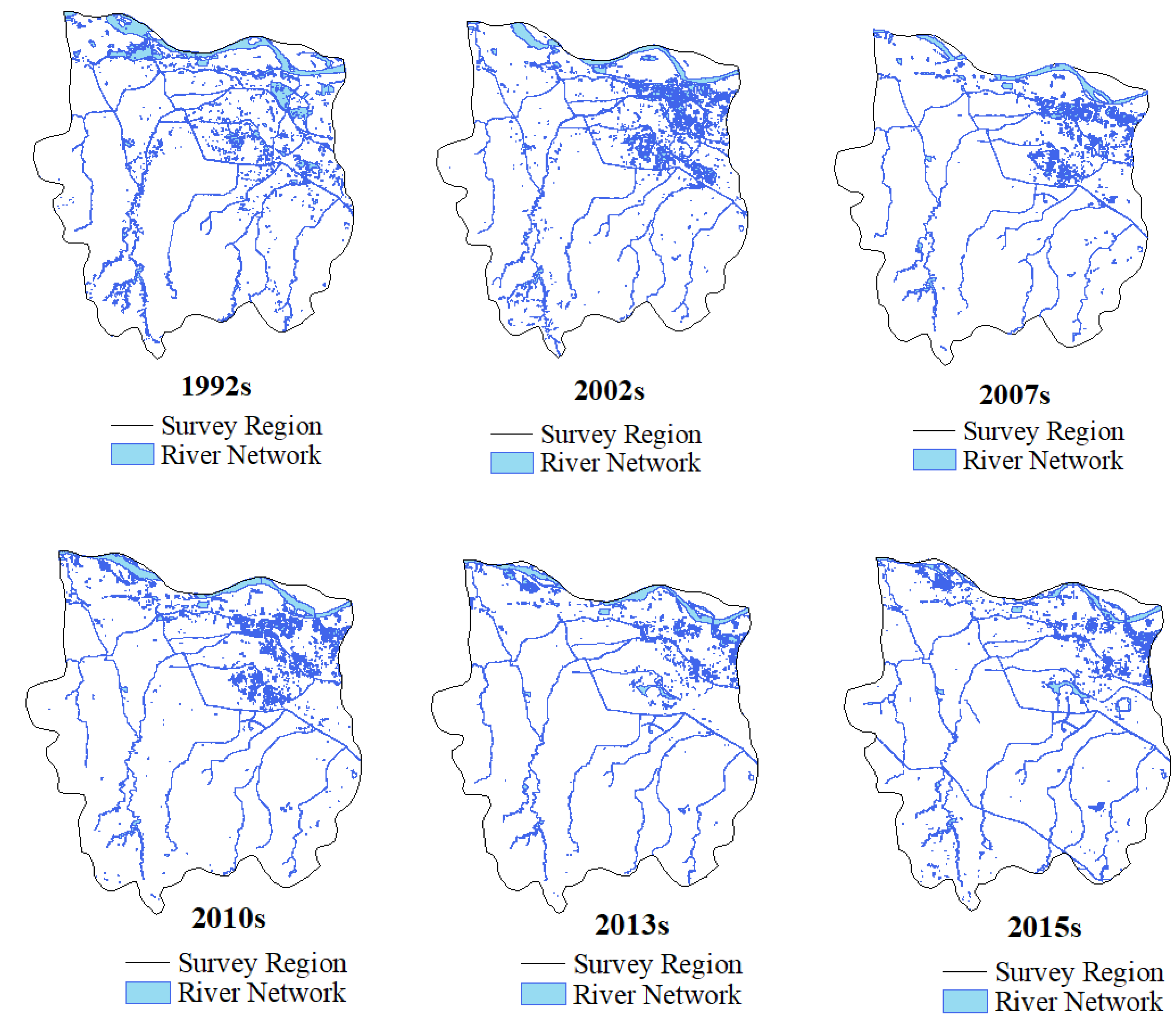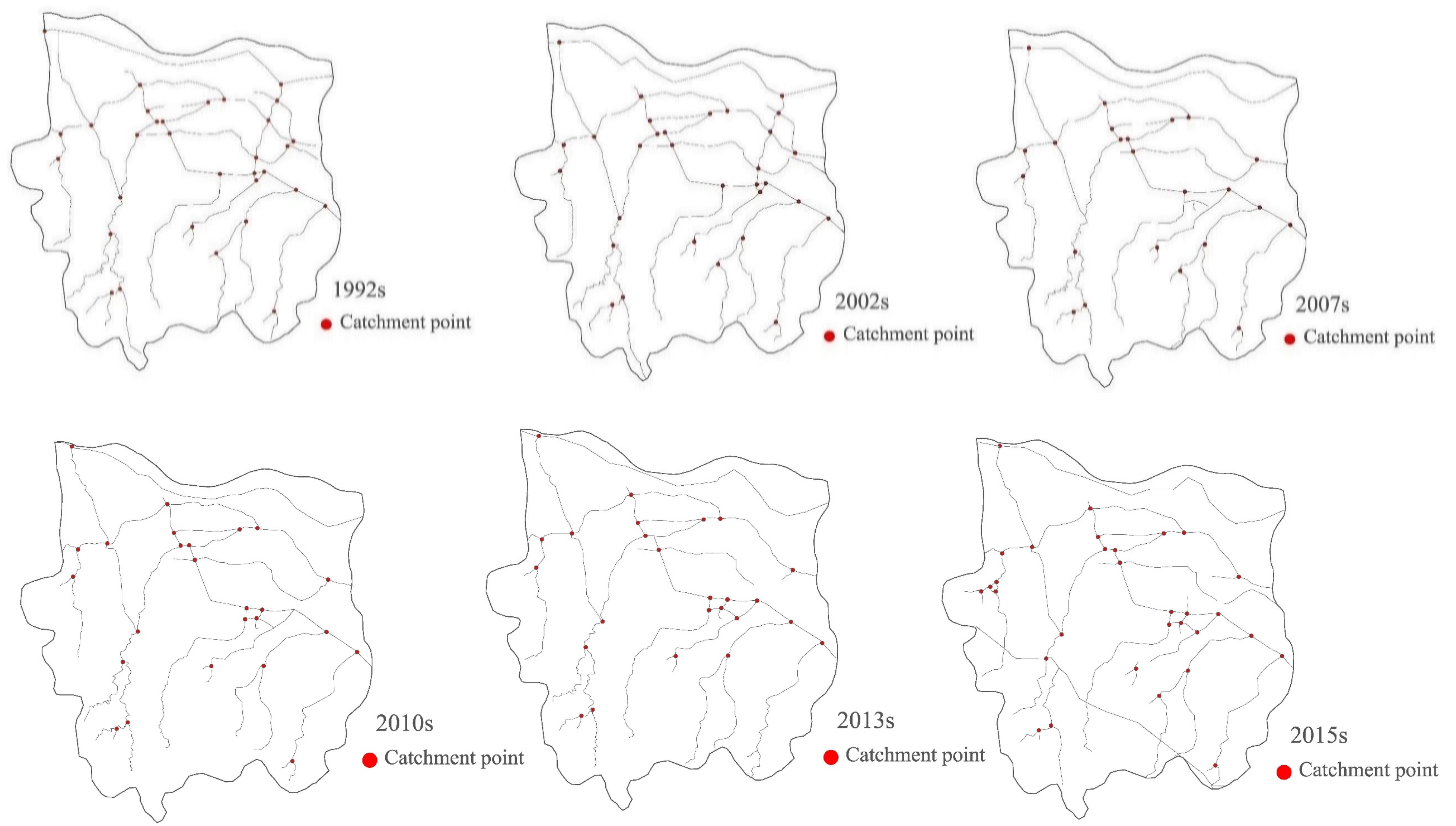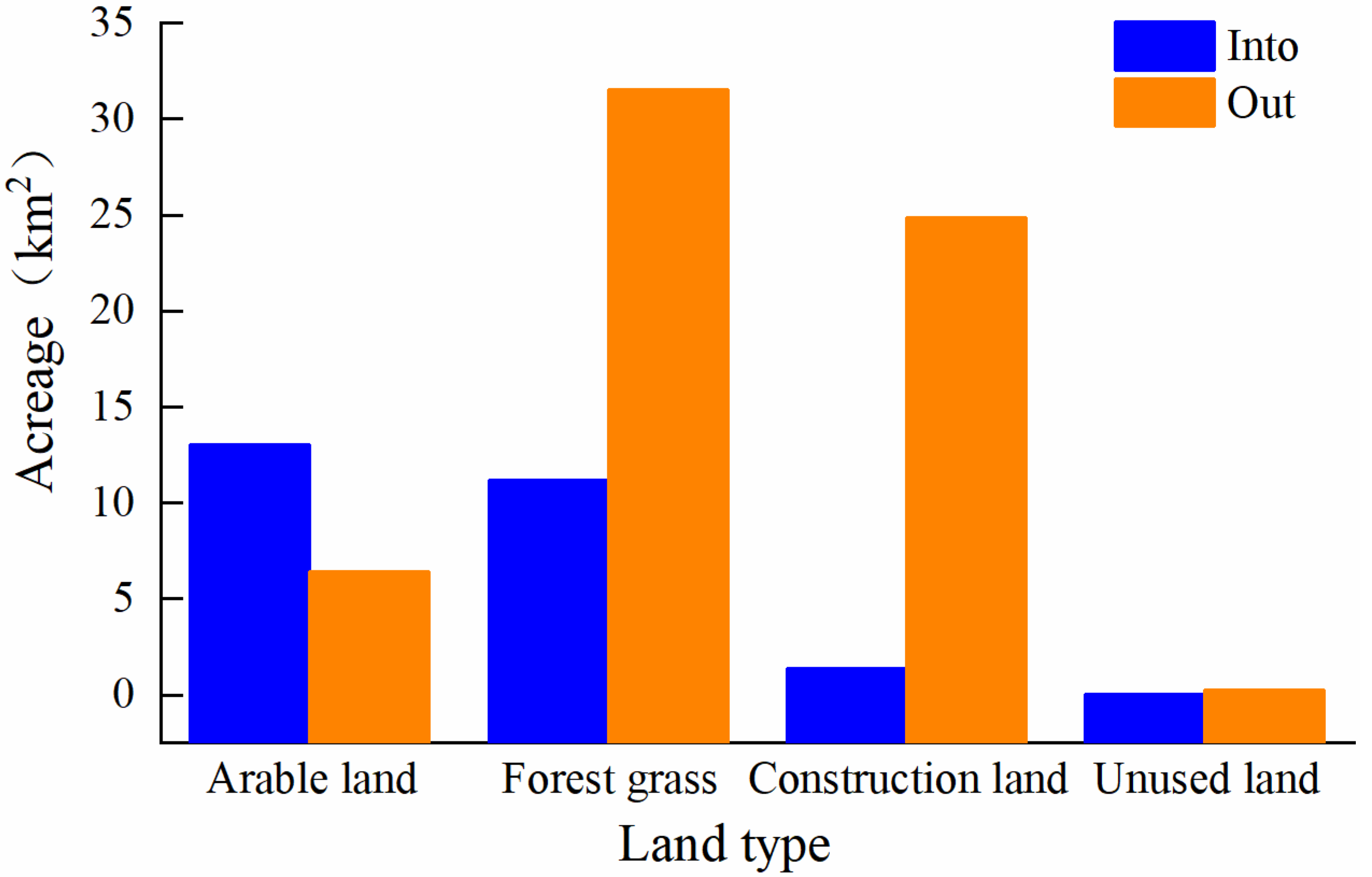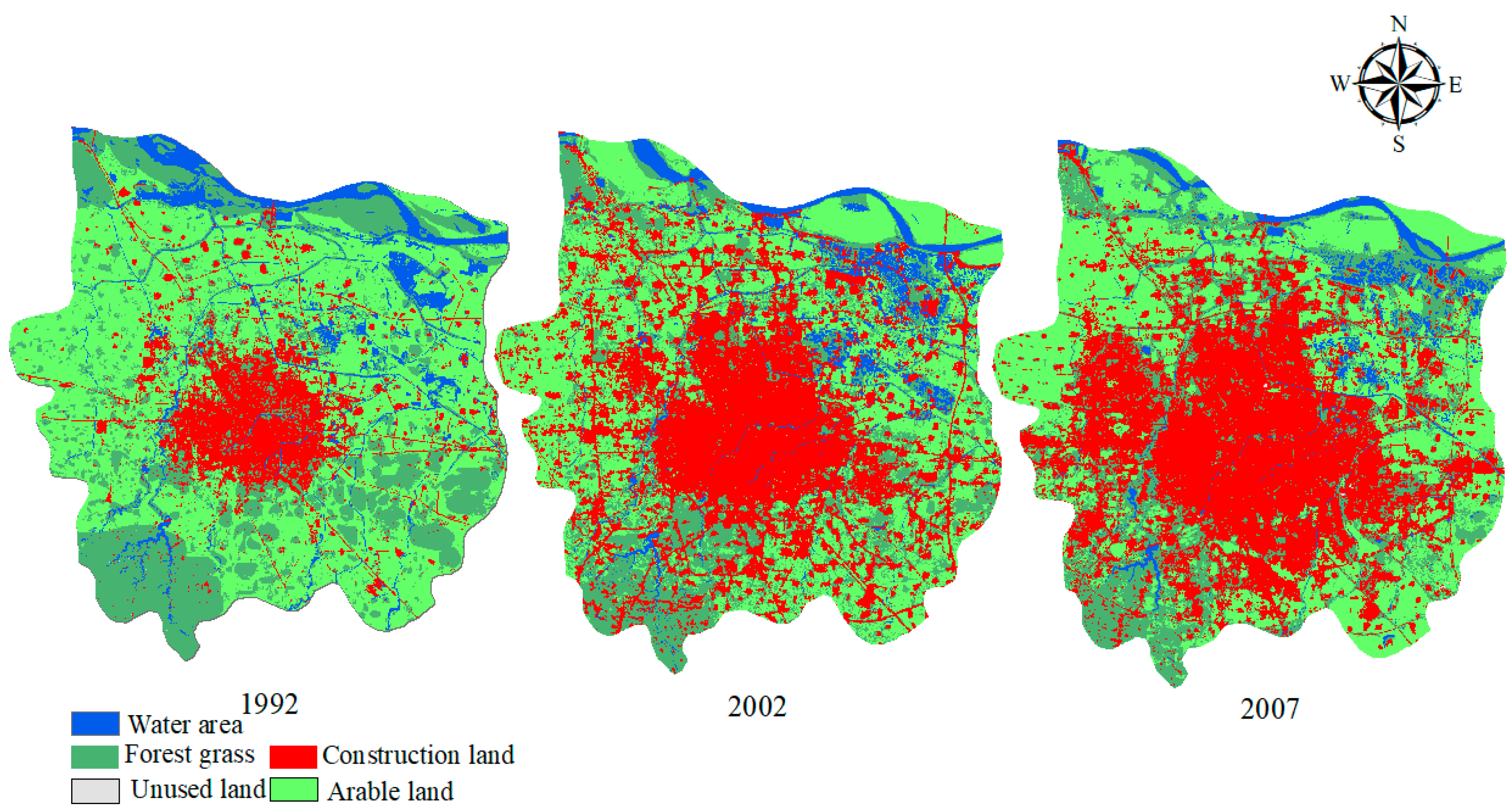1. Introduction
River networks are important for the survival and reproduction of animals and plants, supporting various functions of human society and essentially maintaining ecological stability [
1,
2]. Since the 20th century and during the period of rapid urbanization, human activities associated with urbanization have resulted in nearly 60% of the changes in rivers worldwide [
3,
4]. Typical rivers in northern China have been affected by natural changes and human activities during their evolution, and the growth of these rivers has been strongly impacted by human activities over recent years. Over short time scales, human activities determine changes in the structural details of river networks. The structural characteristics of river networks have an important influence on their storage function, and a reduction in the storage capacity of river networks due to urbanization development is the main cause of current urban flooding [
5]. In general, ecological problems are becoming increasingly prominent, a fact which seriously threatens the sustainable development of human society [
6].
River networks have a variety of ecosystem services [
7]. Neeson (2011) reported on the effects of a river network structure on adult lampreys and their larvae [
8]. Knowing the structure of a river network can also help to identify the location of wastewater discharge and reduce the impact of microbial contamination in the river [
9]. The impact of urbanization on the structure of river networks has long been a concern [
10]. Many highly urbanized areas have lost at least 85% of their river channels, and metropolises such as Chicago have seen the phenomenon of urban stream deserts [
11]. The coral reef is an important ecosystem. It not only provides shelter and breeding grounds for many marine species, but it also controls the level of carbon dioxide and affects the development of urban ecosystems [
12]. The water system structure and environmental function of a river basin can only serve humans for a long time if it is intact. Therefore, some scholars have integrated multiple factors to establish indicators to evaluate river basin systems. For example, Grill (2014) introduced the River Connectivity Index and the River Regulation Index to evaluate the cumulative impact of dams on the Mekong River Basin [
13]. Saunders (2016) used graph theory to quantify the connectivity of marine ecosystems, helping to determine the generality of human impact [
14]. The river ecosystem is complex, and it is difficult to evaluate its health status by establishing a comprehensive index system. Therefore, an effective way to solve this problem is to construct an index evaluation system that is suitable for local river systems based on the actual situation of the target.
Among the regional characteristics of the landscape, the spatial structure of the water system features metric analysis indicators that mainly include the length of the river, node connection rate, river network density, etc. The length is used to determine the degree of contact between the river and the matrix. Node connection rate refers to the degree of spatial continuity of the channel, and whether the channel is disconnected is an important factor in determining its barrier function benefits. Therefore, node connection rate is an important metric of river structure. River network density is used to describe the density of river channels. Phillips (2011) quantified the dynamic hydrological connectivity in heterogeneous basins using a hydrological connectivity function based on graph theory [
15]. Meng et al. (2014) believe that the reduced connectivity of river system structures is closely related to the frequent occurrence of flood disasters in modern cities [
16]. Lin et al. (2019) used Suzhou city as an example to discuss the relationship between changes in the plain river system and its hydrological characteristics under the influence of urbanization [
17]. However, there is insufficient research on the extent to which the river system in the typical northern plain cities is affected by urbanization.
Zhengzhou is one of the most typical cities with regard to the development of urbanization in the Central Plains, and it is also a typical representative of the plain river network in northern China. There are many rivers and lakes in the main urban area of Zhengzhou city, with a crisscross water system and a large water surface ratio. Since the 1990s, the economy of the main urban area has developed rapidly. At the same time, with a series of development plans, such as transportation and housing, the regional inland river network has shrunk, and the impervious area has significantly increased. The relationship between urbanization and river systems has become an important issue to be solved urgently.
Therefore, the objectives of this study were to analyze the temporal and spatial variation characteristics of the river network structure and water system pattern, and quantitatively describe the evolutionary relationship of the regional population, economy, landscape, and urban facilities with the river network in northern China by setting urbanization indicators. The findings of this study could provide a good reference for the protection and development of regional river network structures and water systems in the process of urbanization.
3. Result
3.1. The Urbanization Level of Zhengzhou
Using the entropy value calculation steps, 288 original data points of 10 indicators in study area from 1992 to 2015 were processed, and the corresponding weight values (
, the coefficient of difference) were calculated as shown in
Table 3.
As shown in the calculation of the weighted results, among the selected indicators of the comprehensive evaluation system of urbanization level, the weight ratio of GDP, population density, and urban built-up area rank in the top three, while the weight of tertiary industry accounts for the weakest proportion of GDP. Furthermore, economic growth, population, and land urbanization are the main factors in the urbanization process of Zhengzhou.
A quantitative evaluation of the development level of the urbanization process in Zhengzhou based on an analysis of the selected index data is shown in
Figure 2.
The development process shows that the level of urbanization in Zhengzhou city continued to increase from 1992 to 2015 and was presented as three stages: (1) the stage of contiguous development from 1992 to 2002. The 14th National Congress in 1992 established the goal of developing a socialist market economy. Zhengzhou has nearly doubled in size and is in a phase of rapid development; (2) the period from 2003 to 2007. During this period, China’s accession to the World Trade Organization ushered in new opportunities and challenges in economic development. To adapt to the trend of economic globalization and create new economic growth points in the new century, plans were made to construct the Zhengdong New District, expand the city scale, and complete the leapfrog development; (3) from 2008 to 2015, Zhengzhou intensified its urbanization construction, optimized its industrial structure, and promoted the transformation and upgrading of traditional industries to achieve coordinated economic development and bring Zhengzhou’s urbanization to a new level. The changes in urban population and urban area in Zhengzhou from 1992 to 2015 are shown in
Table 4.
3.2. Analysis of the Evolution of Zhengzhou’s Water System
Artificial neural network classification and MNDWI technology were used to extract information about water bodies in the study area in different periods to determine the pattern of dynamic water system evolution (shown in
Figure 3 and
Figure 4).
Based on the qualitative analysis of the dynamic evolution of the water system in Zhengzhou, it was found that the water area experienced an obvious shrinking trend over the past 34 years. The river in the southwest area of Zhengzhou is significantly degraded, and the completion of the middle route of the South-to-North Water Transfer Project and the beginning of water supply are the main reasons for the increase in the river network density seen in 2015.
By studying the changes in river water grids during different periods, we can provide statistics such as river length
LR, water area
Aω, river network density
DR, water surface rate
WP (%), water system connectivity
γ, and node connection rate
β. Between 1992 and 2002: the river length decreased by an average of 3.83 km per year; the water area decreased by 14.47 km
2; the river network density decreased from 0.47 to 0.43; the water surface ratio and nodal connectivity decreased by 0.014 and 0.06, respectively; the water system connectivity decreased from 0.46 to 0.44; and in terms of the rate of decrease and decline, the overall damage to the water system between 2002 and 2007 was greater than that between 1992 and 2002. During the 2007 to 2010 period: the overall water system pattern index value increased and the structure of the water system improved; the river length increased from 322.17 km to 415.30 km; the water area increased from 50.91 km
2 to 55.07 km
2; the river network density increased to 0.39; the water surface ratio increased from 0.048% to 0.052%; nodal connectivity increased by 0.09; and water system connectivity increased from 0.39 to 0.42. Between 2010 and 2013, there was a slight deterioration, and some of the water system pattern indicators recovered to the 2010 level between 2013 and 2015.Detailed data of the water pattern index are shown in
Table 5. Research and analysis showed that the quantity index, structural characteristic index, and connectivity index of the river network in Zhengzhou city decreased and then increased, which indicated that the structure of Zhengzhou’s water system tended to first deteriorate, and then improve. These changes may be related to the implementation of river regulations and the introduction of artificial wetlands in Zhengzhou in 2007.
3.3. Analysis of the River Network Change Matrix
In 1992, the area of cultivated land, forest, and grassland occupied the majority of all types of land use in Zhengzhou, accounting for 78.68% of the total area of the city, among which the area of cultivated land reached 535.33 km2, accounting for 50.40% of the total area of the city, and the area of water accounted for 7.86%. In 2002, the area of cultivated land remained in first place, while the area of construction land surpassed the area of forest and grassland, reaching second place. In 2007, the area of construction land exceeded the area of arable land and rose to first place, accounting for 422.56 km2, or 39.77%, of the total area. In 2010, the proportion of construction land increased to 43.64%, and the area of water was 55.07 km2, accounting for 5.18%. In 2013, the proportion of construction land was 51.35%, while the proportion of cultivated land, forest, and grassland shrank to 44.28%. The proportion of construction land reached 58.50% in 2015. At this time, the grassland and arable land area was 247.76 km2 and 144.19 km2, respectively, accounting for 36.89%.
The process of change in land-use types in Zhengzhou from 1992 to 2015 was analyzed (
Table 6). The results show that the process of change from water areas to other land-use types is clear. The proportion of arable land, forest, grassland, and construction land that was transferred to water areas is less than 4%. Further analysis of the transfer-in and transfer-out relationship between water areas and other land-use types (
Figure 5) shows that from 1992 to 2015, a total of 25.56 km
2 of different types of land was transferred into water areas, among which arable land was the main contributor, accounting for 50.94% of the total transfer-in area. The amount of water area turned into forest and grassland, construction land, arable land, and unused land was 31.56 km
2, 24.86 km
2, 6.41 km
2, and 0.26 km
2, respectively, with a total area of 63.11 km
2. To summarize, the transfer-out area is larger than the transfer-in area, which has destroyed the natural morphological structure of the river waters to a certain extent.
3.4. Correlation Analysis of Water System Changes and Land-Use Types
The remote sensing interpretation images of Zhengzhou from different periods are shown in
Figure 6. SPSS software (International Business Machines Corporation, New York, USA) was used to test the KS (Kolmogorov-Smirnov) normal distribution of the morphological structure indicators, such as the river network system, land-use type, and urbanization development level index. According to the results of the normal distribution test, a correlation analysis was performed on the morphology of the river network system, the structural characteristics index, and the proportion of each land-use type area, and a Pearson correlation analysis was performed on the data that satisfied the normal distribution test.
The normal distribution test results show that all the data regarding the structural characteristics of the river network conform to the vertical normal distribution. Among these, the types of land use and the proportion of construction land area, unused land, forest grassland, cultivated land, and water area all met the normal distribution test. A correlation analysis was then conducted between the five types of land and the structural indicators of each river network, with the results shown in
Table 7.
The results show that the special indicators of the river network structure (, , , , and ) are significantly correlated with construction land, and their correlation coefficients are all below 0.05. and are significantly correlated with water area and cultivated land; the correlation coefficient with water area is at the 0.01 level, and the correlation coefficient with cultivated land is at the 0.05 level. Although there are certain correlations between the indicators of the river network structure characteristics and other types of land use, the correlation between the two is not significant. This shows that there is a certain internal connection between the river network structure and land-use change; however, the construction land proportion is closely related to the river network structure characteristic index, which indicates that construction land is the main driving factor for the change in the water system pattern. It should also be noted that construction land is negatively correlated with the water pattern of Zhengzhou, and unused land is only negatively correlated with and .

